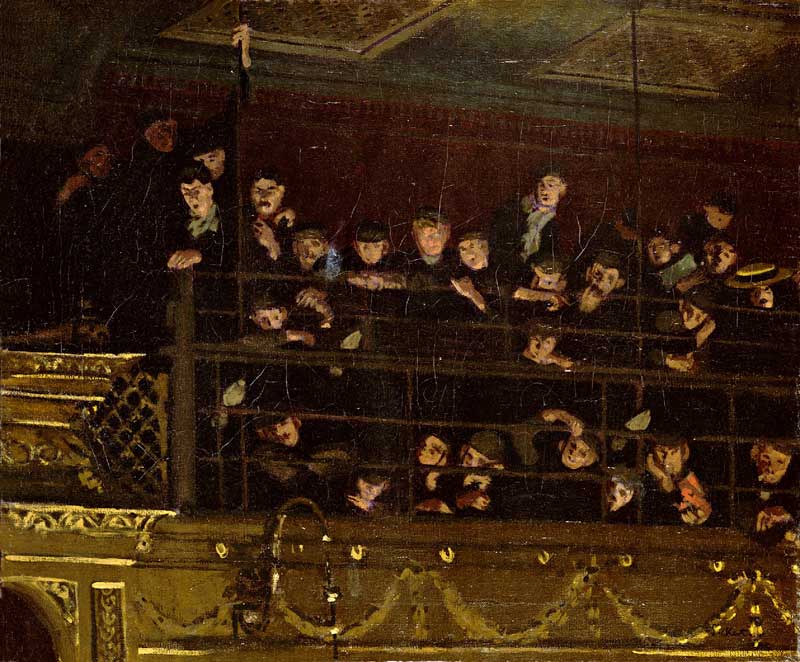Sickert, Walter: Noctes Ambrosianae (1906)
The Independent's Great art series

Also in this article:
About the artist
An audience has great pictorial potential. Artists such as Hogarth, Daumier and Beardsley have made much of audiences. So have cartoonists such as Pont, Fougasse and Bateman.
An audience is a crowd, a closely gathered multitude, a solid mass made up of distinct individuals. They are lookers who are looked at, but who don't imagine they are looked at. Absorbed in their own looking, they present a spectacle of unguarded activity, a feast for the observer.
They are a lexicon of body-language, of attention and response behaviour, both collective and singular. (There is also the implied, off-picture object of their attention.) An audience is rich in pattern possibilities – repetition, randomness, constellation, variety within uniformity, the rule and the exception. It lurks in darkness.
Walter Sickert's Noctes Ambrosianae is a theatre scene: a view not of the stage, but of the house. We see the people up in the gallery – the top tier, the cheapest seats – of the Middlesex Music Hall in Drury Lane. The title holds a laboured, pointed pun. Ambrosian Nights: ambrosia is the food of the gods; "the gods" is the theatrical nickname for the gallery, the high place where the lowest classes, and the impecunious, sit. Maybe there's a suggestion that it's this part of the audience that enjoys the show most freely and heartily, so they are godlike in their pleasures
We're looking up, from some vantage point to be imagined – the stalls, a lower tier on the other side, the stage itself. This is a groundless view, a mid-air cross-section. We're facing a sheer vertical plane that simply falls away at the bottom of the picture. We're looking at a scattered gathering, seen at a distance and in semi-darkness. It's a situation where the shorthand, impressionist technique that Sickert employs is true to experience. This is how the scene would present itself, in half-formed snatches, hard to descry. It's like a background detail of a picture that's become a whole picture.
The gilded mouldings of the balcony catch the light bouncing back from the stage in spots and commas. In the rows above, in an oblong space within the picture's oblong, human traces appear: faces, hands, the grey soles of shoes, where feet are propped up on the railings. The forms of things, postures and gestures, facial expressions, are to be deduced from these brief, telegraphic markings. They are not fully decipherable.
The picture invites different kinds of attention. At one level, it's a Hogarth-like study in the varieties of human behaviour on display, spectators watching a show becoming a half-comic show themselves, with touches of caricature. But the details, sometimes vivid, are fragile. The painted clues don't quite add up, they slip away.
And, at another level, we see the faces in this crowd as anonymous, as apparitions. They appear as an audience appears to an actor on a lit stage, a sea of blurry presences. This effect is also true to an audience's own disembodied sense of itself, sitting in the dark, eyes fixed on a spectacle.
The painting is also an exercise in pattern-making. The pale ghosts become a configuration of separate patches of colour, looming out of darkness, bits of paint from which human interest has all but drained. The scene allows Sickert a free hand in placing these patches within the picture. In the gods, people sit, stand, loll, slump, casually and irregularly, in steep rows. Faces, hands, feet are dotted about in a plane. They can realistically appear at any point. In the stalls, heads are in serried ranks. In the gallery, how they configure is up to the artist.
But realism requires that the ensemble formation shouldn't be too overt, too forced. Sickert puts his patches into an elusive constellation. And without losing a sense of the crowd's randomness, design does subliminally coalesce. In the centre, a dark space opens, a space bounded by an oval ring of faces and hands – an imperfect oval, but detectable enough. The audience parts, and from the heart of the picture, an eye looks out.
This painting is on display in Modern Painters: The Camden Town Group, at Tate Britain, London SW1 (020-7887 8888), until 5 May
The artist
Walter Richard Sickert (1860-1942) is hard to classify. Anglo-Irish-Danish, he was first an actor, then a painter, also a writer. He learnt his art from Degas and Whistler, and added a British taste in narrative and social observation. Founder of the Camden Town Group, he sometimes painted from photos and took his subjects from newspaper stories: celebrities, murders. His colours dare to be as dull as life – as David Sylvester said, "It is rare for painting to match the pallor of reality".
Subscribe to Independent Premium to bookmark this article
Want to bookmark your favourite articles and stories to read or reference later? Start your Independent Premium subscription today.

Join our commenting forum
Join thought-provoking conversations, follow other Independent readers and see their replies